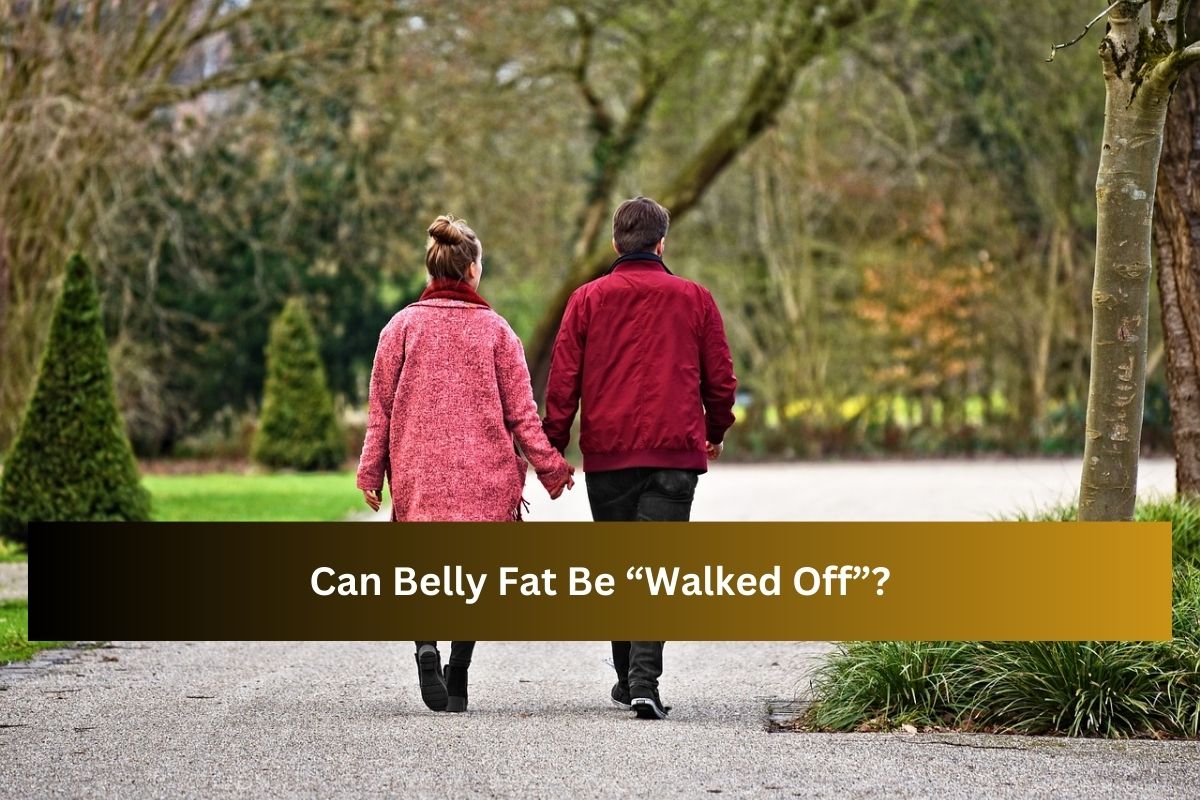When it comes to losing belly fat, people often wonder if simple activities like walking can make a significant difference. Belly fat, also known as visceral fat, is a stubborn and harmful type of fat that accumulates around the abdominal area. While walking alone may not magically melt away all your belly fat, it can be an effective component of a holistic weight loss approach. In this article, we will explore the relationship between walking and belly fat reduction, and discuss how incorporating this low-impact exercise into your routine can contribute to a healthier and more toned midsection.

1. Understanding Belly Fat
1.1 What Is Belly Fat?
Belly fat refers to the adipose tissue located in the abdominal region. It is categorized into two types: subcutaneous fat, which lies just beneath the skin, and visceral fat, which surrounds the internal organs. Visceral fat is the more concerning type as it has been linked to various health issues such as heart disease, diabetes, and certain cancers.
1.2 Why Is Belly Fat a Concern?
Apart from the health risks associated with visceral fat, many individuals also desire a flatter stomach for aesthetic reasons. Excess belly fat can affect body image and self-confidence. Therefore, finding effective strategies to reduce belly fat is a common goal for many people.
2. The Science Behind Fat Loss
2.1 How Does the Body Burn Fat?
The body utilizes stored fat as an energy source through a process called lipolysis. During physical activity, the body breaks down triglycerides (fat molecules) into fatty acids and glycerol, which are then released into the bloodstream. These fatty acids are used by the muscles as fuel, leading to a reduction in overall body fat.

2.2 Can You Spot-Reduce Belly Fat?
Contrary to popular belief, spot reduction of fat in specific areas is not possible. When you engage in physical activity, the body burns fat from various regions, not just the targeted area. Therefore, solely relying on walking to reduce belly fat may not yield the desired results. However, walking can still contribute to overall fat loss and help tone your abdominal muscles.
3. The Role of Walking in Weight Loss
3.1 Benefits of Walking
Walking offers numerous benefits beyond burning calories. It is a low-impact exercise suitable for individuals of all fitness levels. Some benefits of walking include improved cardiovascular health, increased muscle strength, enhanced mood, and reduced stress levels. Moreover, it is a convenient and accessible form of exercise that can be easily incorporated into your daily routine.
3.2 Walking vs. Other Forms of Exercise
While walking may not burn as many calories as higher-intensity exercises like running or cycling, it is still an effective tool for weight management. The key lies in consistency and duration. By maintaining a regular walking routine and gradually increasing the duration and intensity of your walks, you can create a calorie deficit and contribute to overall weight loss, including belly fat reduction.
4. Incorporating Walking Into Your Routine
4.1 Setting Realistic Goals
When starting a walking routine, it is important to set realistic and achievable goals. Begin with a duration and intensity that suits your fitness level and gradually progress over time. Setting small milestones and celebrating your achievements along the way can help maintain motivation and ensure long-term adherence to your walking regimen.
4.2 Creating a Walking Plan
To maximize the benefits of walking, establish a consistent schedule. Aim for at least 150 minutes of moderate-intensity walking per week, spread across several days. Consider incorporating interval training or brisk walking to increase the intensity and calorie burn during your walks. Additionally, make it enjoyable by exploring different routes or walking with a friend or a pet.
5. Enhancing the Effectiveness of Walking
5.1 Adding Intensity to Your Walks
While walking is a low-impact exercise, you can still boost its effectiveness by incorporating interval training or inclines. Alternate between periods of brisk walking and regular walking to elevate your heart rate and increase calorie expenditure. Additionally, walking uphill or on uneven terrain engages more muscles and can further enhance the toning effect on your abdominal area.
5.2 Incorporating Strength Training
Combining walking with strength training exercises can have a synergistic effect on belly fat reduction. Strength training builds lean muscle mass, which increases your resting metabolic rate and enhances fat burning. Include exercises such as planks, squats, and lunges to target and strengthen the core muscles, leading to a more toned midsection.
6. The Importance of a Balanced Diet
6.1 Nutrition for Belly Fat Loss
While exercise plays a crucial role in weight management, it should be complemented by a balanced and nutritious diet. Consume a calorie-controlled diet rich in fruits, vegetables, whole grains, lean proteins, and healthy fats. Avoid or limit processed foods, sugary beverages, and high-fat snacks. Pay attention to portion sizes and practice mindful eating to support your belly fat loss goals.
6.2 Hydration and Its Role in Fat Loss
Proper hydration is often overlooked but essential for overall health and weight management. Drinking an adequate amount of water helps maintain proper bodily functions, supports metabolism, and can help control appetite. Replace sugary drinks with water or herbal teas to reduce calorie intake and support your body’s fat-burning processes.
7. Lifestyle Factors That Impact Belly Fat
7.1 Stress and Sleep
Chronic stress and inadequate sleep have been linked to increased belly fat accumulation. High-stress levels trigger the release of cortisol, a hormone associated with weight gain, particularly in the abdominal area. Prioritize stress management techniques such as meditation, yoga, or engaging in hobbies. Aim for 7-9 hours of quality sleep each night to support overall well-being and facilitate belly fat loss.
7.2 Alcohol Consumption
Excessive alcohol consumption can contribute to the accumulation of belly fat. Alcoholic beverages are high in calories and can increase appetite while impairing judgment regarding food choices. Limit your alcohol intake and opt for healthier alternatives such as mocktails or infused water.
8. Staying Motivated on Your Journey
8.1 Tracking Progress
To stay motivated and track your progress, consider using a fitness tracker or smartphone app that monitors your steps, distance, and calorie burn. Seeing tangible results and surpassing personal records can boost your motivation to continue walking and maintain a healthy lifestyle.
8.2 Finding Accountability and Support
Joining a walking group or partnering with a friend who shares similar fitness goals can provide accountability and support. Having a companion to walk with can make the activity more enjoyable and increase adherence to your walking routine. Share your achievements, challenges, and experiences with like-minded individuals to stay motivated and inspired.
9. The Bottom Line
Walking alone may not be a magic solution for eliminating belly fat, but it can undoubtedly contribute to your weight loss efforts. By incorporating regular and consistent walking into your routine, alongside a balanced diet, strength training, and other healthy lifestyle choices, you can achieve a healthier and more toned midsection. Remember to set realistic goals, stay motivated, and embrace the journey towards a fitter you.
FAQs
10.1 Can walking alone help me lose belly fat?
While walking alone may not specifically target belly fat, it can contribute to overall weight loss and toning of the abdominal muscles. Combining walking with a balanced diet and other forms of exercise can enhance the effectiveness of your weight loss journey.
10.2 How often should I walk to see results?
Consistency is key when it comes to walking for weight loss. Aim for at least 150 minutes of moderate-intensity walking per week, spread across several days. Gradually increase the duration and intensity of your walks to continue challenging your body.
10.3 Is it better to walk at a fast pace or for a longer duration?
Both fast-paced walks and longer-duration walks have their benefits. Brisk walking increases calorie expenditure and cardiovascular fitness, while longer walks contribute to overall calorie burn. Consider incorporating both variations into your routine to keep your workouts diverse.
10.4 Can I walk on a treadmill instead of outdoors?
Absolutely! Walking on a treadmill is a convenient alternative to outdoor walking, especially during inclement weather or for those with limited outdoor access. Adjust the treadmill’s incline and speed settings to simulate outdoor conditions and challenge your body.







